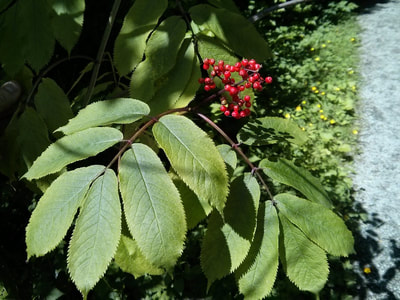Common Name: Elderberry, common elderberry, American elder
Scientific Name:
Family: Adoxaceae
Genus: Sambucus
Species: canadensis
Hardiness Zone: 3 to 9
Height: 5 to 12 ft
Width: 5 to 12 ft
Common Characteristics:
Elderberry is a large multi-stemmed shrub that has a sprawling form. Young stems are tannish white with raised lenticels and older, mature stems develop fissures in the bark. The pith in the stem is solid and white. The leaves are dark green and pinnately compound in an opposite arrangement. They can be 12 inches long and they are 4 to 6 leaflets with a larger terminal leaflet. Margins on leaves tend to be serrated toward the end of the leaf. In the fall, the leaves turn yellow-green. In June, it has little white flowers, that have a slight lemon scent, are clustered into large flat-topped clusters known as cymes. In late summer, the flowers become purple-black elderberry fruit.
Where it Grows:
Elderberry grows in well-drained, acid or alkaline soils with full sun to part shade. It forms colonies through root suckers. There are many ways to prune unless using the shrub for naturalizing an area. Late winter pruning options include pruning out dead or weakened stems, shortening one-year stems, or cutting back to the ground to rejuvenate. For maintaining the best foliage and habit, a hard spring pruning is recommended. It can tolerate moderate drought and moderate flooding. It is also tolerant of road salt.
How it's Used:
The shrub is used for hedges and makes a great landscaping specimen. Mass suckering from the shrub can be beneficial for areas that are being naturalized. Berries are commonly used for wines, jellies, pies, and jams.
Ecosystem Services:
Birds are attracted to the berries and butterflies and other insect pollinators are attracted to the flowers.
Where it is Native to:
Elderberry is native to eastern North America.
Problems:
No serious insect or disease problems. Branches are susceptible to damage from high winds or from heavy snow/ice in winter. Plants will spread by root suckers.
References:
